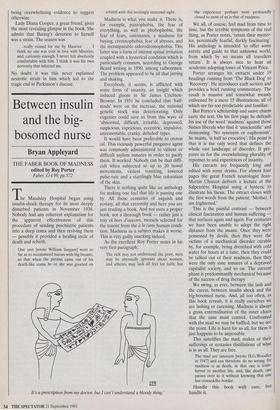Between insulin and the big- bosomed nurse
Bryan Appleyard
THE FABER BOOK OF MADNESS edited by Roy Porter Faber, £14.99, pp.572 The Maudsley Hospital began using insulin-shock therapy for its most deeply disturbed patients in November 1938. Nobody had any coherent explanation for the apparent effectiveness of this procedure of sending psychiatric patients into a deep coma and then reviving them — possibly it provided a healing cycle of death and rebirth.
One unit [wrote William Sargant] went so far as to recommend nurses with big breasts, so that when the patient came out of his death-like coma he or she was greeted on rebirth with this invitingly maternal sight.
Madness is what you make it. There is, for example, pantophobia, the fear of everYthing, as well as phobophobia, the fear of fears, oniomania, a madness for buying, cremnophobia, fear of abysses, and the incomparable siderodromophobia. This latter was a-form of intense spinal irritation coupled with a hysterical condition which is particularly common, according to George Beard writing in 1890, among railwaymen. The problem appeared to be all that jarring and shaking.
Everybody, it seems, is afflicted with some form of insanity, an insight which Induced gloom in Sir James Crichton- Browne. In 1931 he concluded that 'half- mads' were on the increase, the national genetic stock was deteriorating. Only eugenics could save us from this wave of `abnormal, difficult, irritable, depressed, suspicious, capricious, eccentric, impulsive, unreasonable, cranky, deluded' types.
It would have been preferable to croton oil. This viciously powerful purgative agent was commonly administered to violent or difficult asylum inmates in order to pacify them. It worked. Nobody can be that diffi- cult when subjected to up to 20 bowel movements, violent vomiting, lowered pulse-rate and a startlingly blue coloration of the skin.
There is nothing quite like an anthology for making one feel that life is passing one by. All those centuries of anguish and ecstasy, all that extremity and here you are just reading a book. And not even a proper book, not a thorough book — rather just a tray of hors d'oeuvres, morsels selected for the tourist from the a la carte human condi- tion. Madness as a subject makes it worse. This is very guilty snacking indeed.
As the excellent Roy Porter notes in his very first paragraph:
The rich may not understand the poor, men may be abysmally ignorant about women, and atheists may lack all feel for faith; but
It's a prescription from my doctor, but I can't understand a bloody thing.'
the experience perhaps most profoundly closed to most of us is that of madness.
We all, of course, feel mad from time to time, but the terrible symptoms of the real thing, as Porter notes, 'retain their myster- ies, perennially fearful, darkly fascinating'. His anthology is intended 'to offer some entrée and guide to that unknown world, from which by no means all travellers return'. It is always nice to hear an academic adopting tones of Vincent Price.
Porter arranges his extracts under 19 headings running from 'The Black Dog' to `Recovery'. He introduces each section and provides a brief running commentary. The result is massive and somewhat meanly enlivened by a mere 15 illustrations, all of which are far too predictable and familiar.
But Porter's scholarship and suave charm carry the text. On his first page he defends his use of the word 'madness' against those Sixties liberals who find it 'unscientific' and demeaning. 'No synonym or euphemism', he insists, 'is half so evocative'. His point is that it is the only word that defines the whole vast landscape of disorder. It pre- pares us for the overwhelming plurality of reponses to and experiences of insanity.
His extracts are frequently long and edited with some drama. For almost four pages the great French neurologist Jean- Martin Charcot delivers a lecture at the Salpetriere Hospital using a hysteric to illustrate his thesis. The extract closes with the first words from the patient: 'Mother, I am frightened.'
This is the painful contrast — between clinical fascination and human suffering that surfaces again and again. For centuries we have been unable to adopt the right distance from the insane. Once they were possessed by devils, then they were the victims of a mechanical disorder curable, by, for example, being drenched with cold water for hours at a time, then they could be talked out of their madness, then they were the only sane inmates of a depraved capitalist society, and so on. The current phase is predominantly mechanical because of the success of drug therapy
We swing, as ever, between the lash and the caress, between insulin shock and the big-bosomed nurse. And, all too often, as this book reveals, it is really ourselves we are lashing or caressing. Madness is always a gross externalisation of the inner chaos that the sane must control. Confronted with the mad we may be baffled, but we see the point. Life is hard for us all, for them it just happens to be impossible. This sanctifies the mad, makes of their sufferhigs or ecstasies distillations of what is in us all. They are free.
The mad are innocent [wrote H.G.Woodley in 1947] and can therefore do no wrong; for madness is as death, in that one is trans- ferred to another life, and, like death, one passes over to it without knowing that one has crossed, the border.
Handle this book with care, but handle it.


























































 Previous page
Previous page